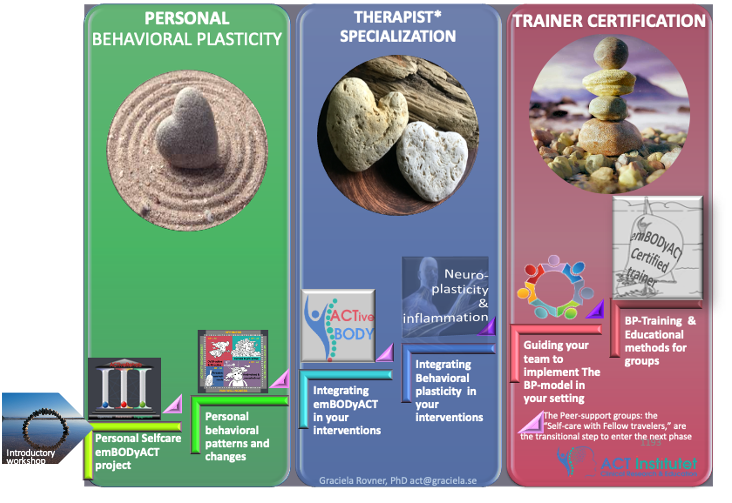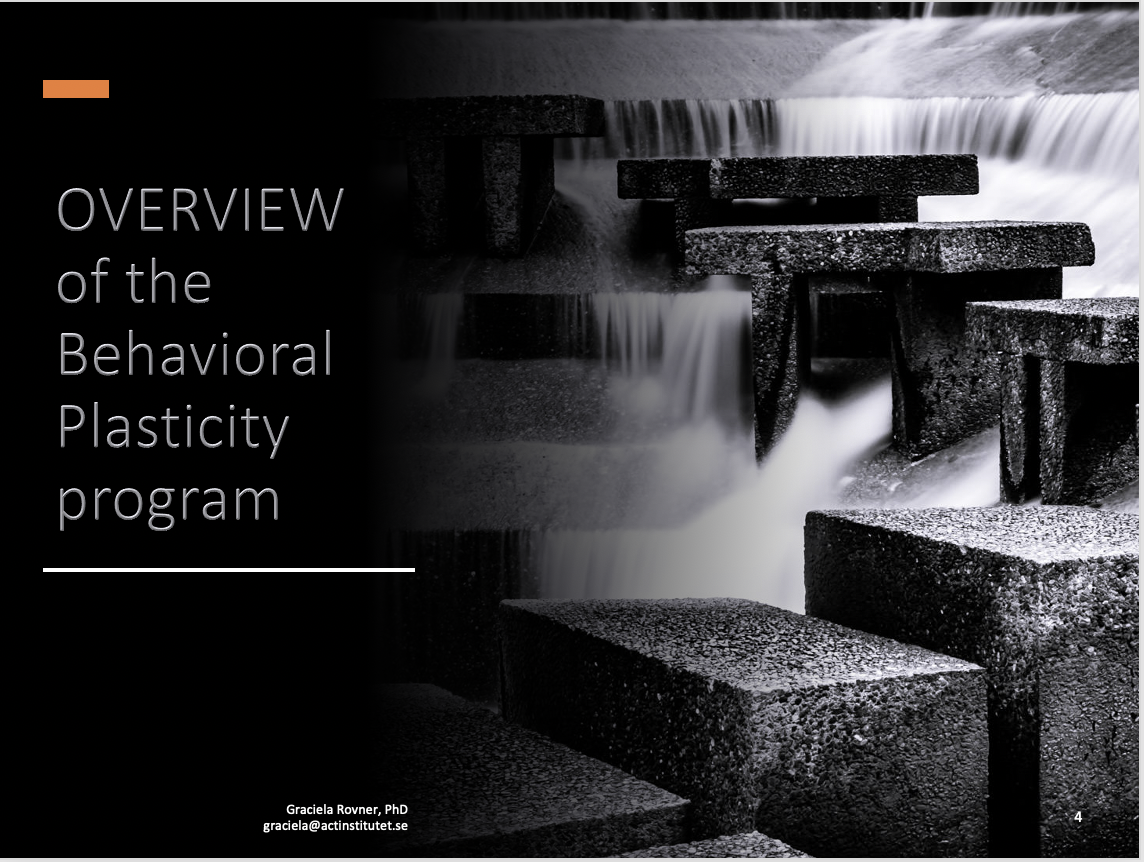About
Our Courses
Embodying
ACT processes
in your practice
What is unique about the Behavioral Plasticity program and its
emBODyACT courses?
Structured Learning Pathway
One of the main problems in learning ACT is the lack of systematic and structured training. The Stepping Stones Learning framework offers an organic progression, clear structure with sequentially planned courses, implementation and continuous support.
A clinical model based on evidence
How do you know which ACT processes are needed for this particular behavioral pattern? Learn about the Behavioral Plasticity patterns, how to assess them in 5 minutes, and design your intervention for groups with shared patterns and needs.
A comprehensive and structured program
To facilitate clinical implementation, our training program consists of three blocks: personal development, professional specialization, and trainer certification. The consecutively organized courses run for several weeks and include assignments and peer-support groups.
emBODyACT, a therapeutic somersault
Learning how to create and guide body-based ACT-consistent exercises often leads to radical changes. Experience the flexibility and power of mindful movement, and breathing techniques. emBODyACT will enrich and empower your interventions and your own life.
Neuroplasticity and ACTiveBODy
Informs how do behaviors influence our neurophysiology and in turn, our behavioral plasticity? The combination of neuroscience & ACT processes will be linked to chronic conditions so you can better influence modern health practices from your own professional field.
Excellent teaching competencies
Dr. Rovner, the only ACT-trainer that is a physiotherapist (PT). She has academic degrees in psychology, Advanced Clinical Education & Work-Integrated Learning. She directs the master-level ACT-course for physiotherapists and occupational therapists at Karolinska Institutet.
The TRAINING PROGRAM
The overall goal of the Behavioral Plasticity program is to enhance the clinicians’ skills and competencies to embody ACT processes to improve their and their clients health and lifestyle-behaviors.
The program has three blocks + intro
0. Introductory workshop
1. The Personal Behavioral Plasticity block
2. The Therapist Behavioral Plasticity block
3. The Trainer’s Behavioral Plasticity block
The blocks
Block 1 is the start for everyone.
It focuses on the implementation of the Behavioral Plasticity framework in your own personal development and healthy lifestyle changes.
Block 2 is for the clinician that aims to also implement the framework in their own interventions, to help clients with chronic conditions to improve their health and functional level (physical, mental, and social).
Block 3 is for the clinician that aims to train and supervise colleagues.

Introductory workshop
Before you register for the program, participate in our introductory 3 hours workshop.
The courses
Each block has 2 courses & peer-support groups.
The courses are via Zoom in relatively small groups. They are designed in modules and run between 6 and 10 weeks. The learning activities are varied, such as lectures, assignments, skills training, own behavioral changes and group meetings between lessons.
Getting Started is Easy
Introduction to emBODyACT
Get inspired in this 3 hours ONLINE workshop!
Find a course in the calendar
Here you will find the list of courses in English.
Are you ready for the next step?
If you have already participated in a short workshop, you can apply for the next course
The Behavioral Plasticity ONLINE program is for you if you are looking forward to…
... getting structure and mentoring in your ACT learning process...
Read More
Spread across several weeks and addresses the learning context beyond typical course content, our program offers three steps, each step has two courses and two peer-support after each course.
This program design bridges the gap created after intensive training or workshops when back to our practice we get stuck with many questions and doubts leading us back to the old way of working.
... learn ACT & more...
Read More
… beyond therapeutical skill and theoretical principles, you will learn more about practicing the ACT principles in your own behavioral changes. In this way, you will learn the skills, get deep insight about how each of the processes of change feels and builds the capacity to motivate, be compassionate, and the resilience needed to create long-lasting behavioral changes.
... adapt the ACT principles in your field
Read More
The Behavioral Plasticity framework was created to 1) include body and movement in the ACT interventions, 2) adapt the ACT principles into all health care professionals* and not only for those offering psychotherapy and 3) to be able to group our patients and clients with shared behavioral pattern and needs and offer tailored (for them) interventions in groups.
The Behavioral Plasticity model offers a common language to understand each other while working in inter-professional (primary-care and rehabilitation settings). It also allows us to better coordinate and integrate the intervention when delivered by several professionals.
... integrate body and movement with ACT principles
Read More
The Behavioral Plasticity framework allows the physiotherapist and occupational therapist to adapt the ACT principles in their interventions, as well as helping the psychologist to integrate the body and movement into psychotherapy. Invaluable skills while working with clients with trauma and stress.
...embody ACT in your self-care practice
Read More
... practice how to guide body-based mindfulness
Read More
We will be creating and practicing how to guide mindfulness and body-centered exercises. How we choose our wording can create totally different functions, we can prompt pliance: i.e. “I would like you to breathe….” or even body-pliance to our mind: i.e. “feel how the air in your exhalations is ‘warmer’ than the air from the inhalation. instead of prompting for discrimination and allowing our and our clients’ bodies to experience whatever they experience, notice it, and labeling with their own voice.
And there is much more to the “hoe to guide in an ACT consistent way”!!
These courses offer a unique space to learn this so neglected aspect of our practice!
... explore the impact of breathing interventions
Read More
…mer info kommer snart!
... understand behavioral patterns
Read More
…mer info kommer snart!
... effectively motivate for behavioral changes
Read More
…mer info kommer snart
... learn more about group-interventions
Read More
Group interventions challenge us, despite their effectivity in many dimensions: improving perspective-taking and social function, decreasing isolation as well as costs. however, the heterogeneity of our clients (despite share symptomatology or diagnoses) can create dysfunctional groups.
Based on our clinical research, we
...grow and learn in an interprofessional context
Read More
Since ACT and the Behavioral Plasticity framework are constructed on mechanisms of action for behavioral changes and NOT on specific tools, techniques, or exercises, there is no need to have a manual.
What we need is to really understand these processes of changes, to be able to do precise and quick assessments, and then use our own toolbox and create exercises that will prompt the appropriated process.
This is not only much more creative, but it is respectful of your own interest, knowledge, and field of expertise.
...be part of international and inter-professional peer-support groups
Read More
...apply clinical relevant research
Read More
... offer VERY short and effective interventions
Read More
These courses are NOT for you if…
...you are interested in ACT "by the book"
Read More
We are around 100 recognized ACTtrainers around the world and most of them offer excellent training as psychotherapy. If you are interested in the original model, I strongly recommend you to take a course with any of them and nowadays there are many courses ONLINE.
In our RESOURSES page, we will be posting some ideas and links to guide you in the right direction.
... you are looking for a short workshop
Read More
ACTiveBODy is a technique that will help you to emBODyACT (where you are a psychotherapist, a physio or a nurse) and also allow you to create innumerable own embody exercises.
‘B’ stands for Balance, ‘O’ for openness, and ‘D’ för the dynamic ACTion. You will learn to implement movement to empower the openes, awareness, and engagement of yours and your clients’ self-care practice.
... you are not interested in your own behavioral changes
Read More
If you just want to add some tools to your professional toolbox, then these courses are not for you, since there is a whole block about your own behavioral changes.
The rationale is that the behavioral Plasticity framework and the capacity to embody the processes of changes are skills that also require to experience what happens when we do changes when we fail when it is challenging when we have setbacks, etc.
The experience of these processes is what will then give us the base for our professional competencies.
... do not need to practice self-care
Read More
... you are not ready to make mistakes and be vulnerable
Read More
…mer info kommer snart
... are interested in an effective method to decrease symptoms
Read More
... are interested to follow treatment protocols
Read More
Since ACT and the Behavioral Plasticity framework are constructed on mechanisms of action for behavioral changes and NOT on specific tools, techniques, or exercises, there is no need to have a manual.
What we need is to really understand these processes of changes, to be able to do precise and quick assessments, and then use our own toolbox and create exercises that will prompt the appropriated process.
This is not only much more creative, but it is respectful of your own interest, knowledge, and field of expertise.
... you strongly believe that individual therapy is best
Read More
Many belive that the only way to tailor an intervention for the client’s needs is offering individual sessions. With the Behavioral Plasticity profiles you can tailor group interventions for clients with share needs and healthy resources. Besides, the social function and the feeling of appartain
... you strongly believe in long therapies
Read More
…mer info kommer snart!
...you are in a hurry to learn ACT
Read More
I this blog I reflect upon the challenges of learning ACT
...you mind tells you that the mind is more important than the body
Read More
Oh well, what else is you mind telling you?
... if you still think that a patient needs to be compliant
Read More
ACT and the Behavioral Plasticity framework do not live that other human beings need to be compliant with us to make changes. The most important and sustainable changes in our lives are done with inner motivation.
So what we need is to get better in motivating them. If our patients/clients do not find our proposal appealing, well, it is not an issue of compliance from their side; it is probably that we are not skilled in motivating and or design an appealing intervention that meets their needs and preferences.
Frequently Asked Questions
Do I need to know ACT to be able to profit from the Behavioral Plasticity courses?
For the personal block, to have previous ACT knowledge is not a requirement, however, it is an asset if you have it.
I am just interested of the specialization, can I skip the first module?
No, the first module is essential. By integrating the ACT processes in your own self.-care and health enhancement practices you will be able to, in the next step, guide other to do the same process.
I am a psychologist/psychotherapist. Is this program going to train me to do ACT as psychotherapy?
We recommend that you start learning ACT from one of the many excellent ACT courses thought by psychologists/psychotherapists, and then when you have started to use it and are ready to include more movement and body-centered exercises in your practice (your daily life and clinical practice) come back and take our courses.
Other ACT trainings are 2 to 4 days’ workshops? Isn’t that a more effective way to learn?
Between lessons is where the learning and skills training really happens. Then the peer-support that these courses offer between lessons facilitates the daily implementation of the new skills as well as offering a place for sharing difficulties and getting help real-time.
What is so special of the courses educational strategy?
‘Conversation Framework-learning’?
I use modern educational methodology adapted to IPL (Inter-professional Learning) using collaborative and Conversation framework-learning techniques. The learning activities (aligned meticulously and constructively with the objectives are six:
Learning by: 1) Acquisition, 2) Practice and experience, 3) Discussions, 4) Collaboration, 5) Investigation, and 6) Production.
Do you have any questions?





